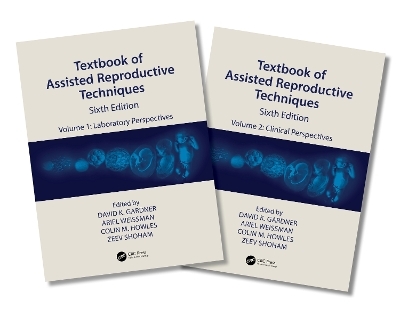
Textbook of Assisted Reproductive Techniques
CRC Press
978-1-032-24534-8 (ISBN)
David K. Gardner AM, FAA, DPhil is the Scientific Director of Melbourne IVF, and a Distinguished Professor in the School of BioSciences at the University of Melbourne, Australia. Ariel Weissman MD is a Senior Physician at the IVF Unit, Department of Obstetrics and Gynecology, Edith Wolfson Medical Center, Holon, and a full Professor of Obstetrics and Gynecology at the Sackler Faculty of Medicine, Tel Aviv University, Tel Aviv, Israel. Colin M. Howles PhD, FRSM is based at Aries Consulting SARL, Geneva, Switzerland, and is an Honorary Fellow, University of Edinburgh, UK. Zeev Shoham MD is a Professor at the Hebrew University, Jerusalem, Israel, a consultant in IVF, and co-founder of IVF-Worldwide.
Volume 1: Laboratory perspectives
Preface
1. Updated guidelines for setting up an assisted reproduction technology laboratory. 2. Quality control maintaining stability in the laboratory. 3. KPIs for the IVF laboratory. 4. QC in the Clouds-Digitizing quality control. 5. The assisted reproduction technology laboratory: Current standards. 6. Evaluation of sperm. 7. Sperm preparation techniques and advanced sperm selection for intracytoplasmic sperm injection. 8. Sperm chromatin assessment. 9. Oocyte retrieval and selection. 10. Preparation and evaluation of oocytes for intracytoplasmic sperm injection. 11. Use of IVM in a clinical setting: What is its role in ART?. 12. Intracytoplasmic sperm injection: Technical aspects. 13. Human embryo biopsy procedures. 14. Analysis of fertilization. 15. Culture Systems for the Human Embryo. 16. Embryo selection through the analysis of morphology and physiology. 17. Evaluation of embryo quality: Time-lapse imaging to assess embryo morphokinesis. 18. Artificial Intelligence (AI). 19. AI in Gamete and Embryo Selection. 20. Demystifying vitrification. 21. Vitrification of the Human Oocyte. 22. The human embryo: vitrification. 23. Managing an oocyte bank. 24. Severe male factor infertility: Genetic consequences and recommendations for genetic testing. 25. Preimplantation genetic testing for aneuploidy to improve clinical outcomes. 26. Diagnosis of endometrial receptivity, embryo–endometrial dialog, and endometrial microbiome. 27. Artificial Gametes: Oocytes. 28. How microfluidics and microfabrication will improve diagnosis and treatment in Human ART. 29. Genome Editing in Human Reproduction. 30. Designing Disaster Plans for IVF Laboratories. 31. Early human embryo development revealed by static imaging.
Index
Volume 2: Clinical perspectives
Preface
32. Quality management in reproductive medicine. 33. The use of digitalisation and precision medicine in the IVF clinic. 34. Lifestyle, periconception, and fertility. 35. Human Reproduction across the Life Course and the Total Environment. 36. Indications for in vitro fertilization treatment. 37. Initial investigation of the infertile couple. 38. Prognostic testing for ovarian reserve. 39. Drugs used for ovarian stimulation: Clomiphene citrate, aromatase inhibitors, metformin, gonadotropins, gonadotropin releasing hormone analogs, and gonadotropins. 40. The role of follicle-stimulating hormone and luteinizing hormone in ovarian stimulation: Current concepts. 41. Endocrine characteristics of assisted reproductive technology cycles. 42. The use of gonadotropin-releasing hormone agonists and the efficiency of in vitro fertilization. 43. Gonadotropin-releasing hormone antagonists in ovarian stimulation for in vitro fertilization. 44. GnRH Agonist Triggering. 45. Segmentation of in vitro fertilization cycles. 46. Controlled ovarian stimulation for freeze-all cycles. 47. Immunology in ART. 48. Monitoring of stimulated cycles in assisted reproduction. 49. Home monitoring of ART cycles. 50. Oocyte collection. 51. Luteal phase support in assisted reproduction techniques. 52. Treatment strategies in assisted reproduction for the poor-responder patient. 53. The Poseidon stratification of ‘Low Prognosis Patients in ART’: Management strategies and outcomes. 54. Controlled ovarian stimulation for low responder patients. 55. Adjuvants for poor responders. 56. Innovative therapies in Diminished Ovarian Reserve (DOR) and Primary Ovarian Insuffiency (POI) patients. 57. Repeated Implantation Failure. 58. Ultrasonography in Assisted Reproduction. 59. Sperm recovery techniques: Clinical aspects and laboratory processing. 60. Embryo Transfer Technique. 61. Cycle regimes for frozen–thawed embryo transfer. 62. The role of the anesthesiologist in In Vitro Fertilization. 63. Endometriosis and ART. 64. Polycystic ovary syndrome and assisted reproduction. 65. Fertility preservation strategies. 66. Uterus transplantation – in transition from experimental to clinical procedure. 67. Viral disease and ART. 68. Fertility options for transgender and nonbinary individuals. 69. Ovarian Hyperstimulation Syndrome. 70. Bleeding, severe pelvic infection, and ectopic pregnancy. 71. Egg and embryo donation. 72. Gestational surrogacy. 73. Patient support in the assisted reproduction technology program. 74. The relationship between stress and In Vitro Fertilization Outcome. 75. Risk and safety management in assisted reproduction technology.
Index
| Erscheint lt. Verlag | 27.12.2023 |
|---|---|
| Zusatzinfo | 102 Tables, black and white; 123 Line drawings, color; 77 Line drawings, black and white; 86 Halftones, color; 31 Halftones, black and white; 209 Illustrations, color; 108 Illustrations, black and white |
| Verlagsort | London |
| Sprache | englisch |
| Maße | 210 x 280 mm |
| Gewicht | 3140 g |
| Themenwelt | Medizin / Pharmazie ► Allgemeines / Lexika |
| Medizin / Pharmazie ► Medizinische Fachgebiete ► Gynäkologie / Geburtshilfe | |
| Medizin / Pharmazie ► Medizinische Fachgebiete ► Urologie | |
| Studium ► 1. Studienabschnitt (Vorklinik) ► Histologie / Embryologie | |
| ISBN-10 | 1-032-24534-4 / 1032245344 |
| ISBN-13 | 978-1-032-24534-8 / 9781032245348 |
| Zustand | Neuware |
| Haben Sie eine Frage zum Produkt? |